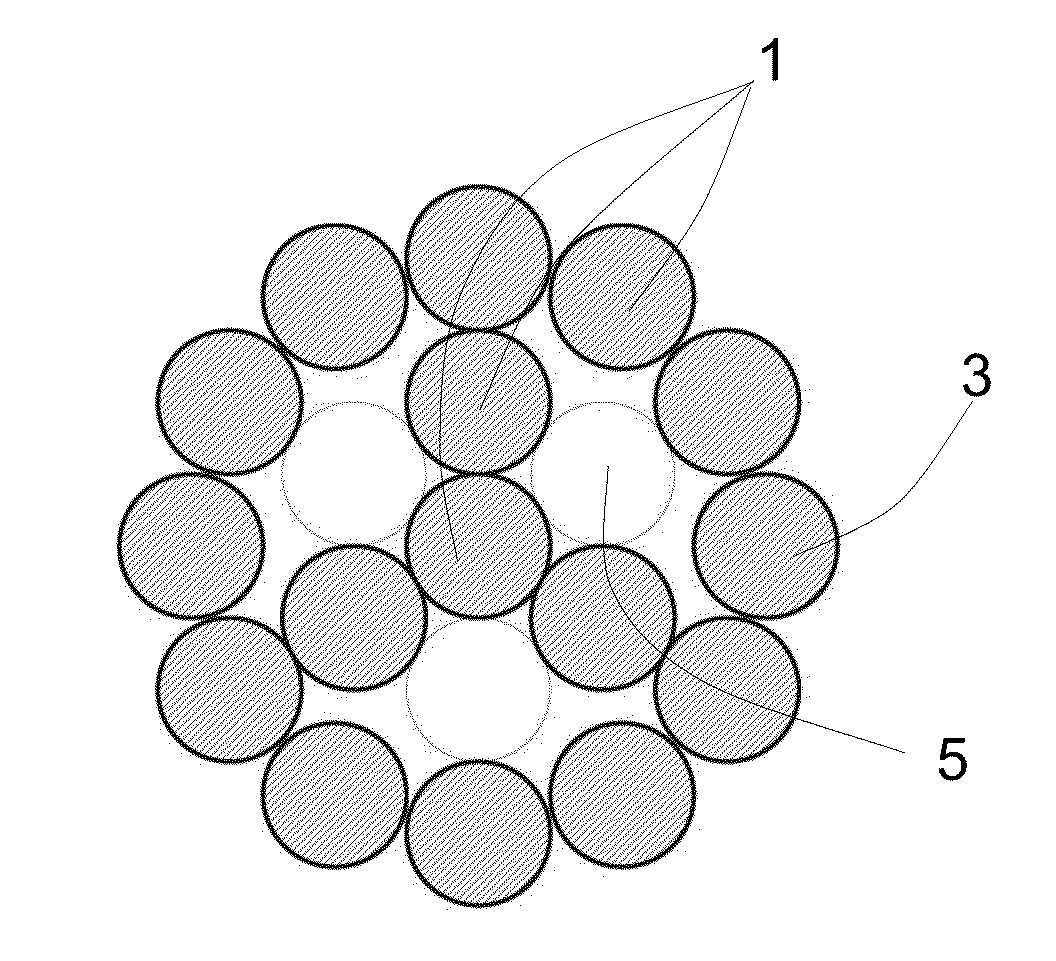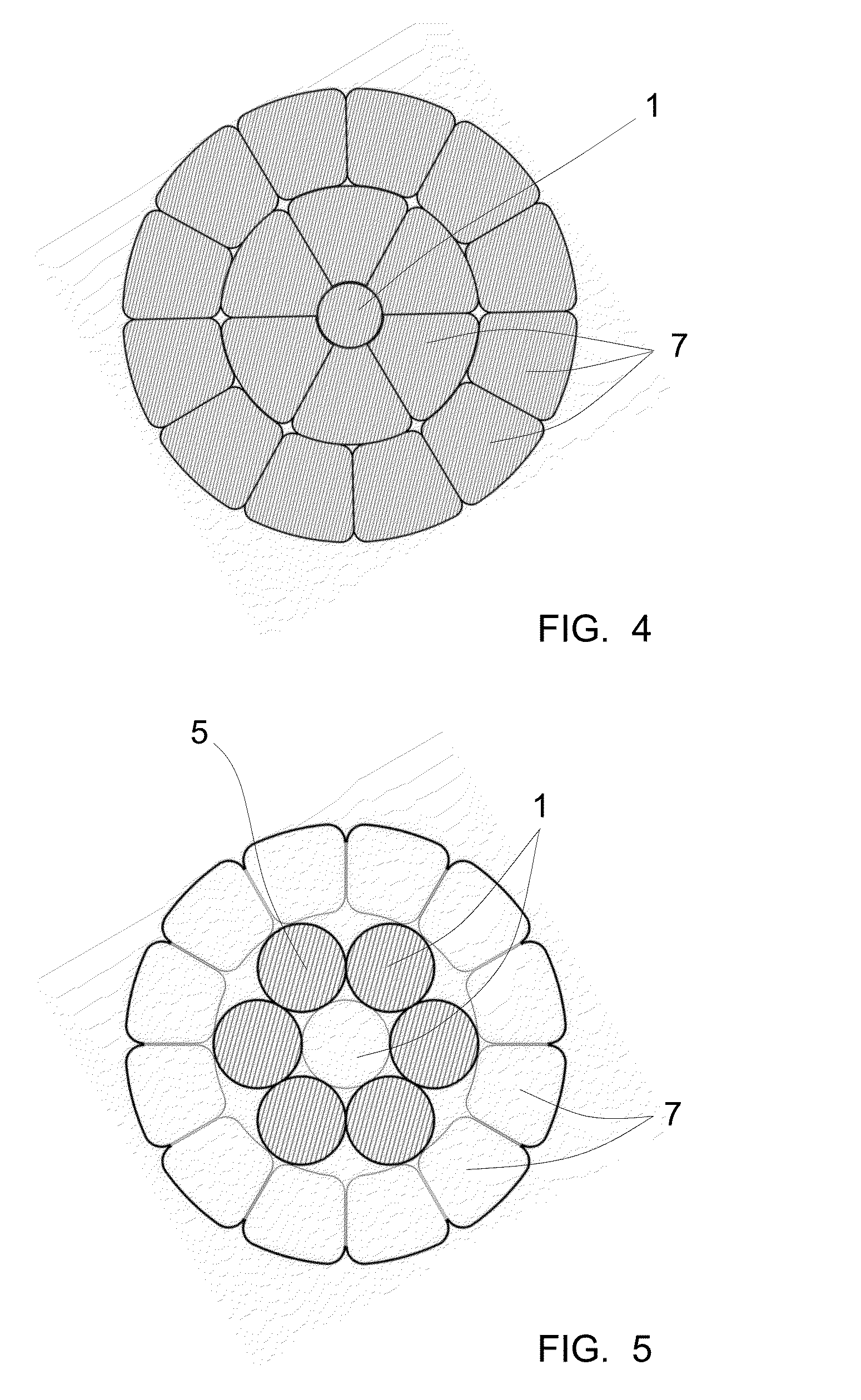Electrical Conductor for Transporting Electrical Energy and Corresponding Production Method
a technology of electrical energy transport and electric conductor, which is applied in the direction of insulated conductors, inorganic insulators, cables, etc., can solve the problems of constant increase in electrical power consumption, and achieve the effects of small catenary sag, good mechanical properties, and high electrical properties
- Summary
- Abstract
- Description
- Claims
- Application Information
AI Technical Summary
Benefits of technology
Problems solved by technology
Method used
Image
Examples
example 1
[0077]A comparative test was carried out between a 95 mm2 microalloyed copper cord with all the wires coated with Xylan 1514® (a polymer composed of polytetrafluoroethylene reinforced with heat resistant resins marketed by Whitford Plastics Ltd. It has a static coefficient of friction of 0.15, and a dynamic coefficient of friction of 0.06), and a cord of the same composition and geometry but without using the coating. The installation was 70 meters in length. When the same voltage was applied to both electrical conductors, the following results were obtained:[0078]with the coated cord, a current intensity of 595 A was reached and a sag of 42 cm[0079]with the uncoated cord, a current intensity of 555 A was reached and a sag of 62 cm[0080]in both cases, the conductor temperature reached 120° C.
[0081]Conclusions: with the electrical conductor formed by coated wires 8% more electrical current is transmitted, and the installation has 48% less sag.
example 2
[0082]A type LA-180 ACSR cable (180 mm2) can work continuously at a maximum temperature of 85° C., which corresponds to a maximum intensity of 425 A. An equivalent conductor thereto, with no need to reinforce the structures, is equivalent to the 95 mm2 microalloyed copper conductor (object of the present invention). This conductor can operate continuously at up to 150° C., and under these conditions, if the wires thereof are coated alternately with fluorinated polymer it can transport an intensity of 700 A. That is to say, 65% more electrical power.
example 3
[0083]Process of application of the fluorinated polymer:[0084]1. Cleaning of the substrate (degreasing)[0085]2. Spraying. It may also be deposited by a dipping or roller impregnation process.[0086]3. If the fluorinated polymer comes in liquid state, it requires drying: 10 min at from 100 to 175° C.[0087]4. Curing: less than 30 minutes at temperatures between 220° C. and 275° C.
[0088]As the curing conditions are at temperatures of above 220° C., if this process is carried out on materials having a lower annealing temperature, their mechanical properties will be affected negatively. Therefore it is particularly advantageous for the conductive material to have an annealing temperature of above the curing temperature. It must be remembered that pure aluminum has an annealing temperature below 120° C., and the annealing temperature of electrolytic copper (ETP) is below 200° C.
PUM
| Property | Measurement | Unit |
|---|---|---|
| diameter | aaaaa | aaaaa |
| diameter | aaaaa | aaaaa |
| temperature | aaaaa | aaaaa |
Abstract
Description
Claims
Application Information
 Login to View More
Login to View More - R&D
- Intellectual Property
- Life Sciences
- Materials
- Tech Scout
- Unparalleled Data Quality
- Higher Quality Content
- 60% Fewer Hallucinations
Browse by: Latest US Patents, China's latest patents, Technical Efficacy Thesaurus, Application Domain, Technology Topic, Popular Technical Reports.
© 2025 PatSnap. All rights reserved.Legal|Privacy policy|Modern Slavery Act Transparency Statement|Sitemap|About US| Contact US: help@patsnap.com



